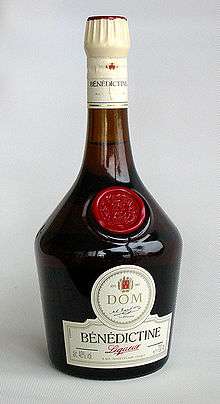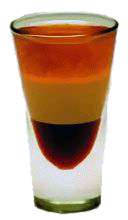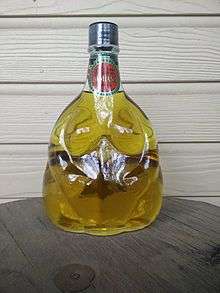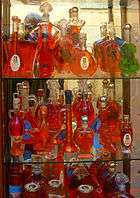Liqueur
A liqueur (US: /lɪˈkɜːr/; UK: /lɪˈkjʊər/; French: [likœʁ]) is an alcoholic drink composed of distilled spirits and additional flavorings such as sugar, fruits, herbs, and spices. Often served with or after dessert, they are typically heavily sweetened and un-aged beyond a resting period during production, when necessary, for their flavors to mingle.

.png)
Liqueurs are historical descendants of herbal medicines. They were made in Italy as early as the 13th century, often prepared by monks (for example, Chartreuse). Today they are produced the world over, commonly served neat, over ice, with coffee, in cocktails, and used in cooking.
In some areas of the United States and Canada liqueurs are also referred to as cordials or schnapps, though the terms refer to different beverages elsewhere.
Etymology
The French word liqueur is derived from the Latin liquifacere, which means "to dissolve".[1][2]
In some parts of the United States and Canada, liqueurs may be referred to as cordials, or schnapps.[3][4] This can cause confusion as in the United Kingdom a cordial would refer to a non-alcoholic concentrated fruit syrup, typically diluted to taste and consumed as a non-carbonated soft drink.[5] Schnapps, on the other hand, can refer to any distilled beverage in Germany and aquavit in Scandinavian countries.[6]
History
Legal definitions
In the United States and Canada, where spirits are often called "liquor" (/ˈlɪkər/), there is often confusion discerning between liqueurs and liquors, due to the many different types of flavored spirits that are available today (e.g., flavored vodka). Liqueurs generally contain a lower alcohol content (15–30% ABV) than spirits[7] and it has sweetener mixed, while some can have an ABV as high as 55%.[8]
Canadian regulations
Under the Food and Drug Regulations (C.R.C., c. 870), liqueurs are produced from mixing alcohol with plant materials.[9] These materials include juices or extracts from fruits, flowers, leaves or other plant materials.[9] The extracts are obtained by soaking, filtering or softening the plant substances. A sweetening agent should be added in an amount that is at least 2.5 percent of the finished liqueur. The alcohol percentage shall be at least 23%.[9] It may also contain natural or artificial flavouring and color.[9]
United States
The Alcohol and Tobacco Tax and Trade Bureau regulates liqueurs similarly to Canada, requiring that alcohol be mixed with plant products and sweeteners be added to at least 2.5% by weight.[10]
Preparation
Some liqueurs are prepared by infusing certain woods, fruits, or flowers in either water or alcohol and adding sugar or other items. Others are distilled from aromatic or flavoring agents.
Anise and Rakı liqueurs have the property of turning from transparent to cloudy when added to water: the oil of anise remains in solution in the presence of a high concentration of alcohol, but crystallizes when the alcohol concentration is reduced; this is known as the ouzo effect.[11]
Use

Cocktails
Liqueurs are sometimes mixed into cocktails to provide flavor.[12]
Layered drinks
Layered drinks are made by floating different-colored liqueurs in separate layers. Each liqueur is poured slowly into a glass over the back of a spoon or down a glass rod, so that the liquids of different densities remain unmixed, creating a striped effect.[13]
Gallery
- Altvater herbal liqueur produced in Austria
 Damiana-based liqueur of Mexico
Damiana-based liqueur of Mexico Fraise strawberry liqueur from the Ardennes, France
Fraise strawberry liqueur from the Ardennes, France
 Demänovka is a traditional Slovak liqueur produced since 1867
Demänovka is a traditional Slovak liqueur produced since 1867 Homemade elder flower liqueur
Homemade elder flower liqueur
See also
- Amaro (liqueur)
- Cordial (medicine)
- Cream liqueur
- Crème liqueur
- Dessert wine
- Fortified wine
- Honey liqueurs and spirits (category page)
- List of liqueurs
- Nalewka
- Schnapps
- Sloe gin
References
- Owens, B.; Dikty, A.; Maytag, F. (2011). The Art of Distilling Whiskey and Other Spirits: An Enthusiast's Guide to the Artisan Distilling of Potent Potables. Quarry Books. p. 106. ISBN 978-1-61673-555-5. Retrieved July 30, 2018.
- Etkin, N.L. (2009). Foods of Association: Biocultural Perspectives on Foods and Beverages that Mediate Sociability. University of Arizona Press. p. 210. ISBN 978-0-8165-2777-9. Retrieved July 30, 2018.
- Lichine, Alexis (1987). Alexis Lichine's New Encyclopedia of Wines & Spirits (5th ed.). New York: Alfred A. Knopf. p. 198. ISBN 978-0-394-56262-9.
- New Oxford American Dictionary (3rd ed.). New York: Oxford University Press. 2010. p. 385. ISBN 978-0-19-539288-3. cordial: "another term for liqueur"
- Dietsch, Michael. "9 Easily Confused Cocktail Terms You Should Know". Serious Eats. Retrieved 31 July 2018.
- Prial, Frank (27 October 1985). "Schnapps, the Cordial Spirit". The New York Times. Retrieved 31 July 2018.
- "How to Tell Your Liquor From Your Liqueur". The Spruce Eats. Retrieved 1 August 2018.
- "Liquor alcohol content". alcoholcontents.com. Retrieved 1 August 2018.
- Branch, Legislative Services. "Consolidated federal laws of canada, Food and Drug Regulations". laws.justice.gc.ca.
- "27 CFR 5.22 – The standards of identity". Retrieved 6 July 2018.
- Sanchez-Dominguez, M.; Rodriguez-Abreu, C. (2016). Nanocolloids: A Meeting Point for Scientists and Technologists. Elsevier Science. p. 369. ISBN 978-0-12-801758-6. Retrieved 2 August 2018.
O/W and W/O nano-emulsions can also be formed without a surfactant by self-emulsification, using the so-called Ouzo effect. The major components of Ouzo (a Greek drink) are trans-anethole, ethanol, and water. Anethole is almost insoluble ...
- Meehan, Jim (12 June 2012). "Embellish Like Bartenders". The New York Times. Retrieved 1 August 2018.
- "Know the Density of Your Liquor To Make the Best Layered Drinks". The Spruce Eats. Retrieved 1 August 2018.
Further reading
- The Liqueur Compounder's Handbook of Recipes for the Manufacture of Liqueurs, Alcoholic Cordials and Compounded Spirits. Bush, W.J. and Co. 1910.
- Kaustinen, E.M. (1985). Production and stability of cream liqueurs made with whey protein concentrate. University of Wisconsin-Madison.
External links
| Look up liqueur in Wiktionary, the free dictionary. |
| Wikimedia Commons has media related to Liqueur. |
- Liqueurs at The Cook's Thesaurus.